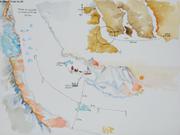Sous la banquise
Why Eric works so hard to plumb the depths...
Vagabond is spending the winter in South Cape Fjord.
A fjord is a long narrow bay, usually quite deep, which has a shallow connection (its “sill”) to the sea. It is formed by the flooding of a river valley that has been scoured out below sea level by a glacier.
The ocean outside supplies seawater to the bottom of the fjord and a river at the upper end supplies less dense fresh water to the surface. The two layers of different density remain distinct as long as the inflows continue and their inter-mingling is inhibited by their density difference.
Wind, tidal current or convection could possibly mix the fjord from surface to seabed if the stabilizing presence of light water over dense were to vanish. Alternatively, denser water from outside can spill over the sill to flood the bottom of the fjord, a process, known as deep-water renewal. Such renewal can bring new oxygenated water to the fjord and force pre-existing nutrient rich bottom water up towards the light. In the absence of mixing and/or renewal bringing up nutrients, there may be relatively little algal growth in fjords and not much marine life.
The description so far pertains to fjords at temperate latitude: the stabilizing structure is maintained by stream flow, wind and tidal currents promote mixing within the fjord and wind outside the fjord may occasionally be the impetus for deep-water renewal.
Fjords in the cold climates work the same way in summer. However, the cold weather of winter shuts off stream flow to the fjord and creates a cap of fast ice that protects the ocean from mixing by the wind. At the same time, the steady freezing of seawater through the winter injects salt into the upper ocean, driving convection and reducing the density contrast between top and bottom waters. This dramatic seasonal change in conditions makes ice-covered fjords very different from their temperate relatives.
There have been very few year-round studies of ice-covered fjords, particularly in locations where fast ice prevails everywhere. Vagabond’s sojourn in South Cape Fjord is providing an opportunity to watch a fjord carefully through the winter, to observe how its structure changes and possibly to understand what makes it tick. There are already some interesting questions. Why was the fjord so rich in marine life (narwhal, harp seal, sea birds) last August? Why is its ice cover now so much thinner than that in nearby waters? Is the near-surface water truly often above freezing temperature? If so, what is driving warmer water towards the surface? Could the same process explain why ice here breaks up 2-4 weeks earlier than in adjacent Jones Sound? Could the same process bring up nutrients so as to make South Cape Fjord a great place for marine life?
An understanding of the physical oceanography of ice-covered fjords also has more general value. Fjords attract humans because they offer good shelter to ships (like Vagabond), and often have level ground for habitation at the upper end. Human waste that ends up in fjords – garbage, sewage, mine tailings for example – ideally remains isolated within the dense bottom water that is trapped behind the sill. However, water contaminated by such waste may possibly be remobilized via deep-water renewal or in ice-covered fjords by winter-time mixing. If remobilized, it could spread elsewhere with undesirable consequences. By contributing to the understanding of Arctic fjords, our study at South Cape promotes the stewardship of a pristine marine environment, soon to be under pressure from resource development and change.

